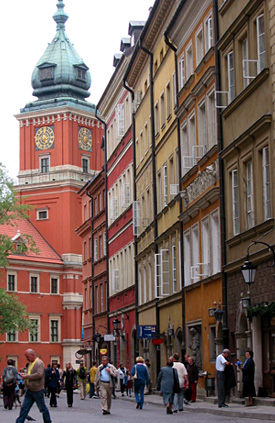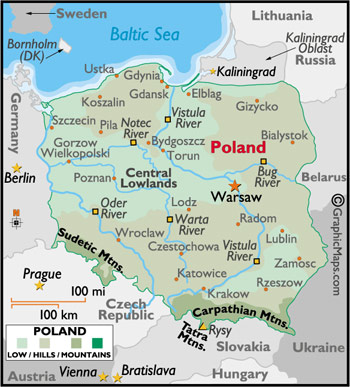| |
Welcome to Warsaw!
Witamy w Warszawie!
Warsaw (Polish: Warszawa) is the capital of Poland. With 1.7
million inhabitants, it is Poland's largest city. Warsaw is located on the
River Vistula (Polish: Wisła), roughly equidistant (350 km, 217
mi) from both the Baltic Sea, which is in the north (Bałtyk) and
the Carpathian Mountains, which are in the southern part of Poland
(Karpaty).
Although not particularly well known among mainstream tourists,
Warsaw has a picturesque Old Town that tells a story, some
remarkable landmarks from the communist era and a skyline full of
skyscrapers, which were developed during the last few years.
One of the most beleaguered of European cities, Warsaw has lived
through many destructive invasions and occupations. The occupation
by Nazi Germany during World War II nearly destroyed the city and
left some 800,000 residents dead. Warsaw survived, however, and is
Poland's capital and largest city.
Its motto is, appropriately,
contemnit procellas, "It defies the storms." Warsaw is
located in central Poland on the Vistula (in Polish, Wisla) River
in a region known as the Middle Polish Lowlands.
|
 |
 |
Warsaw's maximum elevation
is 380 feet (116 meters) above sea level, and it has a moderate,
if not cool, climate. The average July temperature is only 66 F
(19 C), while the average January temperature is 26 F (-3 C).
Rainfall averages 21 inches (53 centimeters) a year.
Although many of Warsaw's historic buildings have been reconstructed
since 1945, the city only partly resembles what it was historically.
The commercial heart of Warsaw was and remains Marszalkowska Street.
This north-south thoroughfare was laid out in 1757 and by the 20th
century was lined with shops, cafes, theaters, and restaurants.
|
|
 |
Since 1955 its major attraction has been the Palace of Culture and Science,
a monumental building located on Defilad Square. This square is the
largest in Warsaw and is used for military parades and other
processions. The building was a gift from the Soviet Union and houses
scientific and cultural institutions as well as theaters and sports
facilities.
The oldest part of Warsaw is Stare Miasto, or Old City, located on the
west bank of the Vistula River north of the Marszalkowska district.
Warsaw's Old City was surrounded by a wall, much of which still stands on
the right side of Podwale Street.
The center of the Old City is the market, a square dating from the
late 13th and early 14th centuries surrounded by houses
painstakingly restored after World War II to their original
15th-century appearance. |
South of the market is the Castle Square, in the middle of which
stands the Sigismund III Vasa column, erected in 1644 and now the
oldest monument in Warsaw. Castle Square was originally the courtyard
of the royal castle, first built in the late 13th and early 14th
centuries but destroyed in 1944. Only its library survived, but the
castle has been rebuilt. Between the market and Castle Square is St.
John's Cathedral, the oldest church in Warsaw.
To the north of the Old City is Nowe Miasto, or New City. This part of
Warsaw dates from the late 14th century and was a center for artisans
and agricultural workers. It too has a market, whose most notable
landmark is the Church of the Nuns of the Holy Sacrament. This baroque
structure was rebuilt after the war. The scientist Marie Curie was
born in this part of Warsaw.
Leading south from Castle Square is Krakowskie Przedmiescie Street,
historically one of Warsaw's most beautiful streets. The University of
Warsaw is on this street, as is the Radziwill Palace, now the seat of
the Presidium of the Polish Council of Ministers. The Square of the
Three Crosses is farther south with the classical St. Alexander's
Church. This church was modeled after the Pantheon in Rome. Poland's
parliament building is nearby.
|
Warsaw Photo Gallery Preview |
 |
 |
 |
 |
 |
Warsaw is one of Poland's major industrial centers. Industry accounts
for almost a third of the city's employment. Until 1989 and the fall
of Communism in the country most businesses were either state- or
cooperatively owned. In 1989 the government began reforms to move
Poland toward privatization and a market economy. Some of the major
products produced here are automobiles, electronic equipment,
stainless steel products, tractors, clothing, precision instruments,
and processed food items. Construction and various trade activities
also employ many Warsaw residents. Consumer goods are frequently in
short supply, and long lines in stores are not uncommon.
Warsaw is Poland's premier educational and cultural center. There are
several institutions of higher learning, including the University of
Warsaw and the Technical University of Warsaw. The National Library,
founded in 1919, has more than 4 million volumes. The Polish Academy
of the Sciences, with its many related research institutes, is located
in Warsaw, as are the National Museum and the Zacheta Art Gallery.
Warsaw has an active musical life. The National Philharmonic plays
here, and the city hosts an international Chopin piano competition and
the International Festival of Contemporary Music. The composer-pianist
Frederic Chopin and the pianist- statesman Ignacy Paderewski both
lived for a time in Warsaw.
Although Warsaw may have existed as far back as the 10th century, its
recorded history begins in the 13th century with a castle built for
the duke of Mazovia. The town around the castle grew and in 1526, when
the last of the Mazovian dukes died, was incorporated into the Polish
kingdom. The royal court was moved to Warsaw in 1611, and the city
became the capital of Poland.
A Swedish invasion devastated Warsaw in 1655-56, and the War of
the Polish Succession (1733-38) brought further decay and
pestilence. A revolt after the second partition of Poland in 1794
was suppressed by Prussian and Russian troops. The third partition
of Poland in 1795 left Warsaw a provincial town of South Prussia.
Napoleon entered the city in 1806 and restored it as the capital of
the newly created Duchy of Warsaw, but most of the duchy was
incorporated as a separate kingdom under Russian sovereignty by the
Congress of Vienna in 1815. Warsaw was invaded during the
Polish-Russian War of 1830-31, and an 1863 insurrection was brutally
suppressed by Russian troops. A period of Russification followed. |
 |

Map Copyright ©
Graphic Maps.com |
Despite its many setbacks, Warsaw continued to grow and had more than
750,000 residents by the turn of the century. A multinational city,
nearly half of its citizens were Jewish during the first decades of
the 20th century. After World War I Warsaw again became the capital of
an independent Poland.
|
Warsaw Photo Gallery Preview |
 |
 |
 |
 |
 |
Warsaw entered its darkest period in 1939. The Nazi invasion at the
beginning of World War II left 10,000 dead and more than 50,000
wounded. The city's cultural treasures were plundered, and its
inhabitants were carried off to labor camps or extermination camps. In
1940 the Jewish ghetto was walled off, and by 1942 more than 300,000
Jews had perished or were sent to death camps. Another 60,000 died in
the ghetto uprising of 1943. Polish resistance to the Nazis centered
in Warsaw and resulted in the insurrection of 1944, a 63-day siege
that left at least another 150,000 dead. After this the Nazis began to
systematically destroy the entire city. When Soviet troops liberated
Warsaw in 1945, they found a city in ruins.
Warsaw remained Poland's capital after the war. The city is divided
into seven precincts. The mayor is appointed by the prime minister,
and there is a popularly elected national council that serves as the
city's legislature. The city of Warsaw and its surroundings form the
Warsaw Capital Province.
 Warsaw Site Menu
Warsaw Site Menu
Warsaw Main Page |
Warsaw Photo Gallery
| Warsaw Facts |
Attractions and Sights |
Warsaw's Royal Castle |
History of Warsaw |
How to Get There - Air and Hotel Info
| Krakow Site
|
Auschwitz Site |
Contact Us | LukeTravels.com
Home Special thanks
to Wikipedia, Wikitravel and its authors. Poland map Copyright Graphic
Maps.com. Warsaw photos Copyright LukeTravels.com and Luke Handzlik.
All Rights Reserved.
|
|



